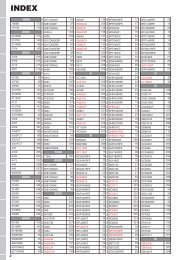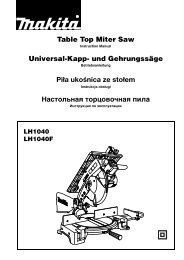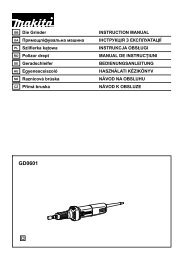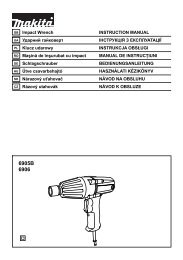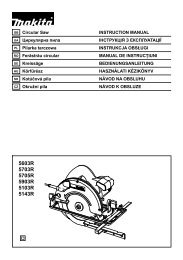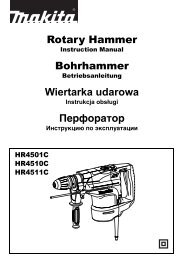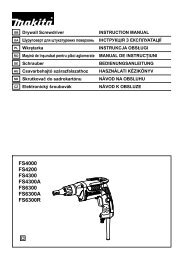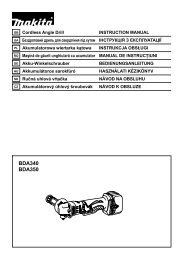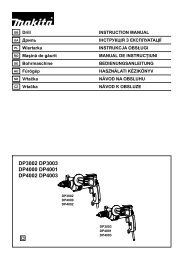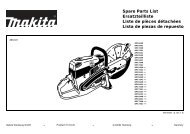DP3002 DP3003 DP4000 DP4001 DP4002 DP4003 - Makita
DP3002 DP3003 DP4000 DP4001 DP4002 DP4003 - Makita
DP3002 DP3003 DP4000 DP4001 DP4002 DP4003 - Makita
Create successful ePaper yourself
Turn your PDF publications into a flip-book with our unique Google optimized e-Paper software.
EN60745<br />
The technical documentation is kept by our authorised<br />
representative in Europe who is:<br />
<strong>Makita</strong> International Europe Ltd.<br />
Michigan Drive, Tongwell,<br />
Milton Keynes, MK15 8JD, England<br />
000230<br />
30.1.2009<br />
Tomoyasu Kato<br />
Director<br />
<strong>Makita</strong> Corporation<br />
3-11-8, Sumiyoshi-cho,<br />
Anjo, Aichi, JAPAN<br />
GEA010-1<br />
General Power Tool Safety<br />
Warnings<br />
WARNING Read all safety warnings and all<br />
instructions. Failure to follow the warnings and<br />
instructions may result in electric shock, fire and/or<br />
serious injury.<br />
Save all warnings and instructions for<br />
future reference.<br />
GEB001-6<br />
DRILL SAFETY WARNINGS<br />
1. Use auxiliary handle(s), if supplied with the<br />
tool. Loss of control can cause personal injury.<br />
2. Hold power tool by insulated gripping<br />
surfaces, when performing an operation<br />
where the cutting accessory may contact<br />
hidden wiring or its own cord. Cutting<br />
3.<br />
accessory contacting a "live" wire may make<br />
exposed metal parts of the power tool "live" and<br />
could give the operator an electric shock.<br />
Always be sure you have a firm footing.<br />
Be sure no one is below when using the tool in<br />
high locations.<br />
4. Hold the tool firmly.<br />
5. Keep hands away from rotating parts.<br />
6. Do not leave the tool running. Operate the tool<br />
only when hand-held.<br />
7. Do not touch the drill bit or the workpiece<br />
immediately after operation; they may be<br />
extremely hot and could burn your skin.<br />
8. Some material contains chemicals which may<br />
be toxic. Take caution to prevent dust<br />
inhalation and skin contact. Follow material<br />
supplier safety data.<br />
SAVE THESE INSTRUCTIONS.<br />
4<br />
WARNING:<br />
DO NOT let comfort or familiarity with product<br />
(gained from repeated use) replace strict adherence<br />
to safety rules for the subject product. MISUSE or<br />
failure to follow the safety rules stated in this<br />
instruction manual may cause serious personal<br />
injury.<br />
FUNCTIONAL DESCRIPTION<br />
•<br />
CAUTION:<br />
Always be sure that the tool is switched off and<br />
unplugged before adjusting or checking function on<br />
the tool.<br />
Switch action<br />
Fig.1<br />
CAUTION:<br />
• Before plugging in the tool, always check to see<br />
that the switch trigger actuates properly and<br />
returns to the "OFF" position when released.<br />
To start the tool, simply pull the switch trigger. Tool<br />
speed is increased by increasing pressure on the switch<br />
trigger. Release the switch trigger to stop.<br />
For continuous operation, pull the switch trigger and<br />
then push the lock lever upward.<br />
To stop the tool from the locked position, pull the switch<br />
trigger fully, then release it.<br />
Reversing switch action<br />
Fig.2<br />
This tool has a reversing switch to change the rotational<br />
direction. Move the reversing switch lever to<br />
the position (A side) for clockwise (forward) rotation or<br />
the position (B side) for counterclockwise (reverse)<br />
rotation.<br />
CAUTION:<br />
• Always check the rotational direction before<br />
operation.<br />
• Use the reversing switch only after the tool comes<br />
to a complete stop. It will damage the tool to<br />
change the rotational direction before the tool<br />
stops.<br />
Hook<br />
Fig.3<br />
Fig.4<br />
When using the hook, pull it out in "A" direction and then<br />
push it in "B" direction to secure in place.<br />
When not using the hook, return it back to its initial<br />
position by following the above procedures in reverse.



